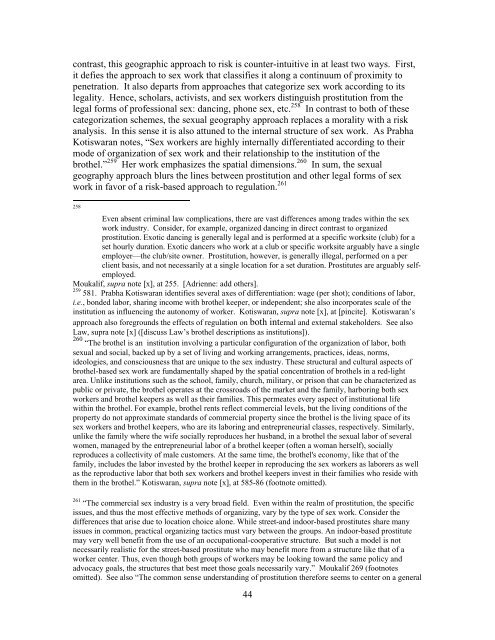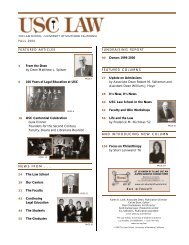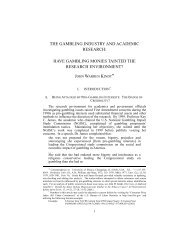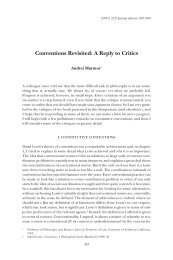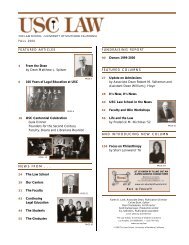1 Regulating Sex Work Adrienne D. Davis VERY ROUGH DRAFT ...
1 Regulating Sex Work Adrienne D. Davis VERY ROUGH DRAFT ...
1 Regulating Sex Work Adrienne D. Davis VERY ROUGH DRAFT ...
You also want an ePaper? Increase the reach of your titles
YUMPU automatically turns print PDFs into web optimized ePapers that Google loves.
contrast, this geographic approach to risk is counter-intuitive in at least two ways. First,<br />
it defies the approach to sex work that classifies it along a continuum of proximity to<br />
penetration. It also departs from approaches that categorize sex work according to its<br />
legality. Hence, scholars, activists, and sex workers distinguish prostitution from the<br />
legal forms of professional sex: dancing, phone sex, etc. 258 In contrast to both of these<br />
categorization schemes, the sexual geography approach replaces a morality with a risk<br />
analysis. In this sense it is also attuned to the internal structure of sex work. As Prabha<br />
Kotiswaran notes, “<strong>Sex</strong> workers are highly internally differentiated according to their<br />
mode of organization of sex work and their relationship to the institution of the<br />
brothel.” 259 Her work emphasizes the spatial dimensions. 260 In sum, the sexual<br />
geography approach blurs the lines between prostitution and other legal forms of sex<br />
work in favor of a risk-based approach to regulation. 261<br />
258<br />
Even absent criminal law complications, there are vast differences among trades within the sex<br />
work industry. Consider, for example, organized dancing in direct contrast to organized<br />
prostitution. Exotic dancing is generally legal and is performed at a specific worksite (club) for a<br />
set hourly duration. Exotic dancers who work at a club or specific worksite arguably have a single<br />
employer—the club/site owner. Prostitution, however, is generally illegal, performed on a per<br />
client basis, and not necessarily at a single location for a set duration. Prostitutes are arguably selfemployed.<br />
Moukalif, supra note [x], at 255. [<strong>Adrienne</strong>: add others].<br />
259 581. Prabha Kotiswaran identifies several axes of differentiation: wage (per shot); conditions of labor,<br />
i.e., bonded labor, sharing income with brothel keeper, or independent; she also incorporates scale of the<br />
institution as influencing the autonomy of worker. Kotiswaran, supra note [x], at [pincite]. Kotiswaran’s<br />
approach also foregrounds the effects of regulation on both internal and external stakeholders. See also<br />
Law, supra note [x] ([discuss Law’s brothel descriptions as institutions]).<br />
260 “The brothel is an institution involving a particular configuration of the organization of labor, both<br />
sexual and social, backed up by a set of living and working arrangements, practices, ideas, norms,<br />
ideologies, and consciousness that are unique to the sex industry. These structural and cultural aspects of<br />
brothel-based sex work are fundamentally shaped by the spatial concentration of brothels in a red-light<br />
area. Unlike institutions such as the school, family, church, military, or prison that can be characterized as<br />
public or private, the brothel operates at the crossroads of the market and the family, harboring both sex<br />
workers and brothel keepers as well as their families. This permeates every aspect of institutional life<br />
within the brothel. For example, brothel rents reflect commercial levels, but the living conditions of the<br />
property do not approximate standards of commercial property since the brothel is the living space of its<br />
sex workers and brothel keepers, who are its laboring and entrepreneurial classes, respectively. Similarly,<br />
unlike the family where the wife socially reproduces her husband, in a brothel the sexual labor of several<br />
women, managed by the entrepreneurial labor of a brothel keeper (often a woman herself), socially<br />
reproduces a collectivity of male customers. At the same time, the brothel's economy, like that of the<br />
family, includes the labor invested by the brothel keeper in reproducing the sex workers as laborers as well<br />
as the reproductive labor that both sex workers and brothel keepers invest in their families who reside with<br />
them in the brothel.” Kotiswaran, supra note [x], at 585-86 (footnote omitted).<br />
261 “The commercial sex industry is a very broad field. Even within the realm of prostitution, the specific<br />
issues, and thus the most effective methods of organizing, vary by the type of sex work. Consider the<br />
differences that arise due to location choice alone. While street-and indoor-based prostitutes share many<br />
issues in common, practical organizing tactics must vary between the groups. An indoor-based prostitute<br />
may very well benefit from the use of an occupational-cooperative structure. But such a model is not<br />
necessarily realistic for the street-based prostitute who may benefit more from a structure like that of a<br />
worker center. Thus, even though both groups of workers may be looking toward the same policy and<br />
advocacy goals, the structures that best meet those goals necessarily vary.” Moukalif 269 (footnotes<br />
omitted). See also “The common sense understanding of prostitution therefore seems to center on a general<br />
44


